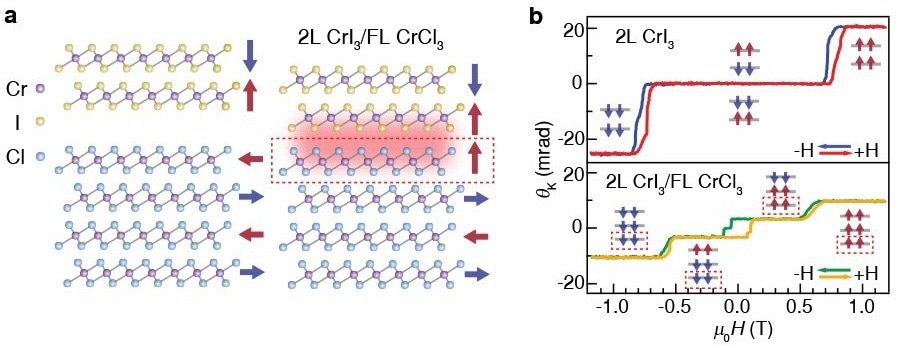New platforms for investigating unusual magnetic orders and quantum phenomena have emerged in the form of van der Waals (vdW) magnets and their heterostructures.
 Schematics of the magnetic ground states in bilayer (2L) CrI3 and few-layer (FL) CrCl3 before (left) and after (right) forming heterostructure. A ferromagnetic interfacial coupling emerges at the interface. (b) MOKE results of the 2L CrI3 and the 2L CrI3/FL CrCl3 heterostructure. A significant square hysteresis loop is observed for the heterostructure indicating the interfacial ferromagnetism with perpendicular anisotropy (absent in either 2L CrI3 or FL CrCl3 by itself). Insets depict magnetic ground states. Image Credit: Yong P. Chen et al.
Schematics of the magnetic ground states in bilayer (2L) CrI3 and few-layer (FL) CrCl3 before (left) and after (right) forming heterostructure. A ferromagnetic interfacial coupling emerges at the interface. (b) MOKE results of the 2L CrI3 and the 2L CrI3/FL CrCl3 heterostructure. A significant square hysteresis loop is observed for the heterostructure indicating the interfacial ferromagnetism with perpendicular anisotropy (absent in either 2L CrI3 or FL CrCl3 by itself). Insets depict magnetic ground states. Image Credit: Yong P. Chen et al.
However, there is still a lot of unexplored ground when it comes to combining two different magnetic orders and analyzing the magnetic proximity at the interface. By doing this, it could be possible to establish exotic magnetic phases and properties and modulate magnetic interactions.
The heterostructures of layered antiferromagnets, CrI3 and CrCl3, with perpendicular and in-plane magnetic anisotropy, respectively, have now been studied by an international team of researchers from Japan, the USA, Denmark, and China. On December 15th, 2022, they published their findings in the journal Nature Communications.
Professor Yong P. Chen, the principal investigator at Tohoku University’s Advanced Institute for Materials Research (WPI-AIMR), served as the team’s leader. Chen also teaches at the universities of Purdue and Aarhus in Denmark.
The experiments for the study were carried out by Dr. Guanghui Cheng, an assistant professor at WPI-AIMR who worked in Chen's Laboratory.
The magnetic behaviors were characterized down to a few atomic layers by Chen and his team using magneto-optical Kerr effect microscopy.
Remarkably, we observed an emergent interfacial ferromagnetism when bringing these two antiferromagnets together, with an even higher critical temperature than both the constituent materials.
Yong P. Chen, Principal Investigator and Professor, Advanced Institute for Materials Research, Tohoku University
The team proved that the layer of CrCl3 close to CrI3 establishes an out-of-plane magnetic order. Comparing the interfacial magnetism to the previously studied gate-tunable vdW magnet device, the interfacial magnetism demonstrated significantly improved electric-field tunability (such as doping-dominated control in bilayer CrI3).
The heterostructure’s naturally broken structural inversion symmetry, which permits previously unheard-of direct spin-charge coupling, is credited with the novel tunability.
Chen added, “These findings point to exciting opportunities to explore exotic magnetic phases and engineer novel spintronic devices in vdW heterostructure.”
Journal Reference:
Cheng, G., et al. (2022) Emergence of electric-field-tunable interfacial ferromagnetism in 2D antiferromagnet heterostructures. Nature Communications. doi:10.1038/s41467-022-34812-6.